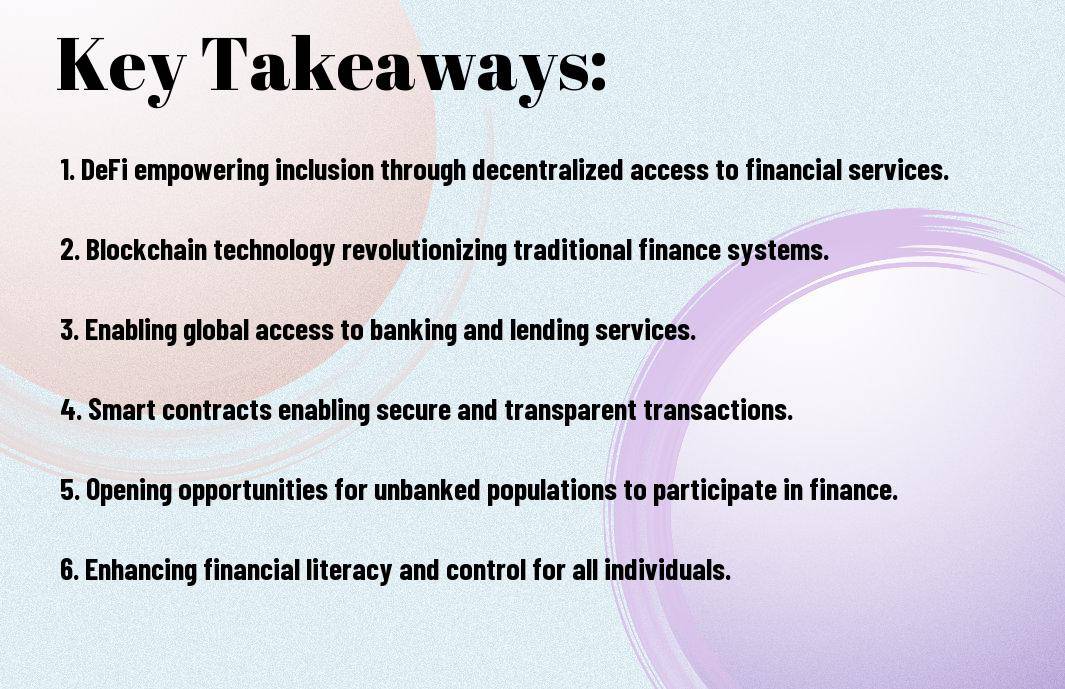
Newsletter Subscribe
Enter your email address below and subscribe to our newsletter

Enter your email address below and subscribe to our newsletter

Most experts in the financial technology sector can agree that Decentralized Finance (DeFi) is one of the most revolutionary developments in recent years. Enabled by blockchain technology, DeFi is reshaping traditional financial systems and opening up a world of opportunities for financial inclusion like never before. By eliminating intermediaries and allowing for peer-to-peer transactions, DeFi is providing individuals worldwide with access to banking services, loans, and investments that were previously out of reach.


Clearly, blockchain technology plays a pivotal role in enabling financial inclusion through decentralized finance (DeFi) solutions. According to a study on blockchain technology for digital financial inclusion in the…, blockchain’s distributed ledger system allows for secure, transparent, and efficient transactions without the need for intermediaries.
Role: At the core of blockchain technology is a decentralized database that maintains a continuously growing list of records, or blocks, linked and secured using cryptography. Each block contains a timestamp and a link to the previous block, forming a chain – hence the name blockchain. This structure ensures the immutability and transparency of transactions, making it an ideal technology for DeFi applications.
Role: Smart contracts are self-executing contracts with the terms of the agreement directly written into code. These contracts automatically execute and enforce agreements when predefined conditions are met, eliminating the need for intermediaries and reducing the risk of fraud. Smart contracts play a crucial role in enabling automated transactions and programmable money within the DeFi ecosystem.
Technology: Automated transactions powered by smart contracts enable trustless interactions between parties, as the code enforces and executes the terms of the agreement without human intervention. This not only streamlines processes but also reduces costs and mitigates the potential for human error, making financial transactions more efficient and secure.
To ensure the security and transparency of decentralized systems, blockchain networks rely on consensus mechanisms like proof of work or proof of stake to validate transactions and secure the network. These consensus mechanisms involve network participants reaching an agreement on the validity of transactions, making it difficult for malicious actors to manipulate the system.
Decentralized ledgers provide a higher level of security compared to centralized systems, as data is distributed across multiple nodes, eliminating central points of failure. This decentralized nature not only enhances security but also promotes transparency, as anyone can verify transactions on the blockchain, fostering trust in the system.
Not long ago, the concept of decentralized finance (DeFi) was merely a glimmer in the eye of blockchain enthusiasts. DeFi aims to recreate traditional financial systems utilizing blockchain technology to provide greater accessibility, transparency, and inclusivity. In its early stages, DeFi projects focused on basic financial services such as lending, borrowing, and trading, all without the need for intermediaries like banks.
One significant milestone in the evolution of DeFi was the introduction of Ethereum in 2015, which provided the infrastructure for developers to build decentralized applications (dApps). This led to a wave of innovation in the DeFi space, with projects like MakerDAO pioneering decentralized stablecoins and Compound Finance introducing interest-earning opportunities for cryptocurrency holders.
As the industry grew, more complex DeFi protocols emerged, offering services such as decentralized exchanges (DEXs), yield farming, and algorithmic trading. These advancements not only expanded the functionality of DeFi but also attracted a broader audience of users looking to participate in the decentralized financial ecosystem.
LandscapeOne of the most remarkable aspects of the current DeFi landscape is the sheer variety of projects and protocols available to users. From lending platforms like Aave to DEXs like Uniswap, DeFi offers a diverse range of financial services that cater to different needs and preferences. The total value locked in DeFi protocols has surged to over billions of dollars, reflecting the growing popularity and adoption of decentralized finance.
DeFi has not been without its challenges, with security vulnerabilities and smart contract exploits posing risks to users’ funds. However, the community’s response to these incidents has been swift, with developers implementing measures to enhance the security and resilience of DeFi protocols. Despite these risks, the positive impact of DeFi on financial inclusion and innovation cannot be understated, making it a key driver of the ongoing evolution of the financial landscape.

Once again, the rise of DeFi has been transforming the traditional financial landscape, offering innovative solutions for various financial services. According to the OECD, decentralized finance (DeFi) plays a significant role in enabling financial inclusion through its decentralized protocols and platforms.
On the forefront of DeFi innovation are various protocols and platforms that facilitate decentralized finance services. These include lending protocols like Compound and Aave, decentralized exchanges (DEXs) such as Uniswap and SushiSwap, and liquidity provision platforms like Balancer and Curve. These platforms operate on blockchain technology, enabling seamless and secure peer-to-peer transactions without the need for intermediaries.
For individuals looking to access funds or earn passive income, DeFi offers lending, borrowing, and yield farming opportunities. Borrowers can leverage their crypto assets as collateral to borrow funds, while lenders can earn interest by supplying their assets to lending pools. Yield farming involves optimizing returns by moving assets between different DeFi protocols to maximize yields.
Borrowing: While borrowing in traditional finance usually involves extensive paperwork and credit checks, DeFi lending platforms allow users to borrow funds instantly with crypto collateral, providing greater accessibility and efficiency.
To participate in trading cryptocurrencies without relying on centralized exchanges, users can turn to decentralized exchanges (DEXs) like Uniswap and PancakeSwap. These platforms enable users to swap tokens directly from their wallets, while liquidity pools ensure that there is sufficient liquidity for trading pairs. This eliminates the need for order books and central authorities, providing a more decentralized trading experience.
Various: DeFi also offers various asset tokenization solutions and stablecoins, allowing users to represent real-world assets digitally and mitigate volatility risks through pegged stablecoins. These innovations expand the possibilities for asset ownership and cross-border transactions, contributing to the democratization of finance.
Banking: Despite the established presence of traditional banking institutions, Decentralized Finance (DeFi) is disrupting the conventional financial services sector. DeFi platforms offer a range of services such as lending, borrowing, and trading without the need for intermediaries like banks. This disintermediation reduces costs, speeds up transactions, and provides users with more control over their finances.
Finance: Despite the widespread availability of banking services, many individuals around the world still lack access to basic financial tools. DeFi is bridging this gap by offering decentralized financial services to anyone with an internet connection. This inclusivity empowers individuals who are underserved by traditional banks to participate in global financial markets, access credit, and engage in various financial activities.
Plus: By leveraging blockchain technology, DeFi platforms are able to operate 24/7, without the limitations of traditional banking hours or geographical boundaries. This flexibility allows users to engage with financial services at their convenience, facilitating greater financial inclusion and accessibility.
Tools: While DeFi poses as a disruptor to traditional banking, there is potential for synergy between the two systems. Traditional banks can leverage DeFi technology to enhance their services, improve efficiency, and reduce costs. By incorporating elements of DeFi into their operations, banks can stay competitive in a rapidly evolving financial landscape.
Access: Collaboration between traditional banks and DeFi platforms can broaden financial inclusion by combining the strengths of both systems. Banks bring regulatory compliance, security, and customer trust, while DeFi offers innovation, speed, and cost-effectiveness. This collaboration can create a more robust financial ecosystem that benefits both institutions and consumers alike.

Risks: As decentralized finance (DeFi) continues to gain traction, regulatory scrutiny and legal considerations have become a major concern. The uncharted territory of DeFi raises questions about jurisdictional oversight, anti-money laundering (AML) compliance, and investor protection. Regulatory clarity is crucial to foster innovation while ensuring consumer safety. Smart contracts, the cornerstone of DeFi, operate in a borderless environment, making it challenging for regulators to enforce compliance and protect consumers.
DeFi: One of the most pressing challenges facing DeFi is scalability. As the number of users and transactions on decentralized platforms increases, scalability becomes a critical issue. The current infrastructure of blockchain networks, such as Ethereum, may not be able to handle the rising demand, leading to network congestion and high transaction fees. Layer 2 solutions and interoperability protocols are being developed to address these scalability issues and enhance the efficiency of DeFi applications.
Scalability: Users engaging in DeFi protocols are exposed to a range of risks, including hacks, frauds, and market volatility. The decentralized nature of DeFi platforms leaves them vulnerable to cyber attacks and security breaches. Smart contract vulnerabilities and code exploits can be exploited by malicious actors to steal funds or manipulate markets. Volatility in cryptocurrency prices can also lead to significant losses for users participating in DeFi activities.
Technical: It is vital for users to exercise caution and conduct thorough due diligence before participating in DeFi projects. Implementing security best practices, such as using hardware wallets, verifying smart contract code, and diversifying investments, can help mitigate risks associated with hacks, frauds, and volatility. Education and awareness are key to protecting oneself in the rapidly evolving landscape of decentralized finance.
Now, as we look towards the future of decentralized finance (DeFi) and its role in financial inclusion, the potential for global economic empowerment is vast. With the ability to transact without traditional intermediaries, individuals in underserved regions can access financial services previously out of reach.
DeFi has the potential to revolutionize the way financial services are accessed and utilized globally. By providing a platform for peer-to-peer transactions, loans, and investments, DeFi opens up opportunities for individuals in developing countries to participate in the global economy. This could lead to increased financial independence and empowerment for millions who are currently excluded from traditional banking systems.
Global collaborations and advancements in blockchain technology are paving the way for exciting innovations in the DeFi space. From decentralized exchanges to yield farming and asset management protocols, the possibilities for expanding financial services in a decentralized manner are endless. These innovations have the potential to reshape the financial landscape and create new opportunities for economic growth and inclusion.
To further enhance the impact of DeFi, integrating real-world assets and services into decentralized platforms is crucial.
Financial institutions and regulators are beginning to explore ways to bridge the gap between traditional finance and decentralized systems. By tokenizing assets such as real estate, commodities, and even intellectual property, DeFi platforms can offer a wider range of investment opportunities to users. This integration has the potential to bring more liquidity and efficiency to traditional markets while ensuring greater transparency and security through blockchain technology.
To wrap up, the rise of DeFi through blockchain technology has shown great promise in revolutionizing the financial landscape by enabling greater access to financial services for underserved populations. By leveraging decentralized platforms, smart contracts, and digital assets, DeFi is paving the way for increased financial inclusion and empowerment around the world.
As the DeFi ecosystem continues to evolve and mature, it is crucial for regulators, policymakers, and industry stakeholders to collaborate in order to address challenges, ensure security, and uphold consumer protection standards. By embracing this innovative technology responsibly, we can harness the full potential of blockchain for the betterment of global financial systems and advance towards a more inclusive and equitable future.
A: DeFi, short for Decentralized Finance, refers to a variety of financial applications in cryptocurrency or blockchain geared towards eliminating intermediaries and enabling direct peer-to-peer transactions.
A: Blockchain technology provides the underlying infrastructure for DeFi by allowing transparent, secure, and immutable transactions without the need for traditional financial institutions.
A: DeFi offers benefits such as financial inclusion, lower transaction costs, increased privacy, and accessibility to financial services for the unbanked population.
A: Popular DeFi applications include decentralized exchanges (DEXs), lending platforms, liquidity pools, yield farming, and token swapping protocols like Uniswap and Compound.
A: DeFi promotes financial inclusion by providing access to financial services for individuals who are traditionally underserved or excluded by the traditional financial system, such as those without access to banks or in regions with unstable economies.
A: Risks associated with DeFi include smart contract vulnerabilities, hack attacks, regulatory uncertainties, market volatility, and the potential for loss of funds due to human error.
A: To get started with DeFi, one can research and choose a reputable DeFi platform, set up a digital wallet, fund the wallet with cryptocurrency, and start exploring different DeFi applications or investment opportunities with caution and due diligence.